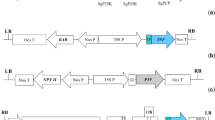Abstract
The balloon flower (Platycodon grandiflorum) is a popular traditional medicinal plant used in Korea to treat conditions such as bronchitis, asthma, tuberculosis, diabetes, and inflammatory diseases. Recently, immunopharmacological research identified triterpenoid and saponin as important active compounds in P. grandiflorum. To study and extract these compounds and other metabolites from P. grandiflorum, a technique was developed for producing hairy root cultures, which are a reliable source of plant compounds. To achieve this, the activity of Agrobacterium rhizogenes was exploited, which can transfer DNA segments into plant genomes after infecting them. In this study, the A. rhizogenes strain R1000 was determined that had the highest infection frequency (87.5%) and induced the most hairy roots per plant, and the concentration of antibiotics (75 mg/l kanamycin) was elucidated for selection after transformation. Wild-type and transgenic hairy roots contained various phenolic compounds, although both of them had similar concentrations of phenolic compounds. In the future, the protocols described here should be useful for studying and extracting valuable metabolites such as phenolic compounds from P. grandiflorum hairy root cultures.




Similar content being viewed by others
References
Gurib-Fakim A (2006) Medicinal plants: traditions of yesterday and drugs of tomorrow. Mol Aspects Med 27:1–93
Christey MC, Braun RH (2005) Production of hairy root cultures and transgenic plants by Agrobacterium rhizogenes-mediated transformation. Methods Mol Biol 286:47–60
Georgiev MI, Pavlov AI, Bley T (2007) Hairy root type plant in vitro systems as sources of bioactive substances. Appl Microbiol Biotechnol 74:1175–1185
Srivastava S, Srivastava AK (2007) Hairy root culture for mass-production of high-value secondary metabolites. Crit Rev Biotechnol 27:29–43
Takagi K, Lee EB (1972) Pharmacological studies on Platycodon grandiflorum A. DC. Activities of crude platycodin on respiratory and circulatory systems and its other pharmacological activities. Yakugaku Zasshi 92:969–973
Lee EB (1973) Pharmacological studies on Platycodon grandiflorum A. DC. IV. A comparison of experimental pharmacological effects of crude platycodin with clinical indications of Platycodi radix. Yakugaku Zasshi 93:1188–1194
Nikaido T, Koike K, Mitsunaga K, Saeki T (1999) Two new triterpenoid saponins from Platycodon grandiflorum. Chem Pharm Bull 47:903–904
Ishii H, Tori K, Tozyo T, Yoshimura Y (1984) Saponins from roots of Platycodon grandiflorum. Part 2. Isolation and structure of new triterpene glycosides. J Chem Soc, Perkin Trans 1:661–668
Ahn JC, Hwang B, Tada H, Ishimaru K, Sasaki K, Shimomura K (1996) Polyacetylenes in hairy roots of Platycodon grandiflorum. Phytochemistry 42:69–72
Murashige T, Skoog F (1962) A revised medium for rapid growth and bioassays with tobacco tissue culture. Physiol Plant 15:473–497
Edwards K, Johnstone C, Thompson C (1991) A simple and rapid method for the preparation of plant genomic DNA for PCR analysis. Nucleic Acids Res 19:1349
Sundaresan V, Springer P, Volpe T, Haward S, Jones JD, Dean C, Ma H, Martienssen R (1995) Patterns of gene action in plant development revealed by enhancer trap and gene trap transposable elements. Genes Dev 9:1797–1810
Vanhala L, Hiltunen R, Oksman-Caldentey K-M (1995) Virulence of different Agrobacterium strains on hairy root formation of Hyoscyamus muticus. Plant Cell Rep 14:236–240
Mateus L, Cherkaoui S, Christen P, Oksman-Caldentey K-M (2000) Simultaneous determination of scopolamine, hyoscyamine and littorine in plants and different hairy root clones of Hyoscyamus muticus by micellar electrokinetic chromatography. Phytochemistry 54:517–523
Tiwari RK, Trivedi M, Guang ZC, Guo G-Q, Zheng G-C (2007) Genetic transformation of Gentiana macrophylla with Agrobacterium rhizogenes: growth and production of secoiridoid glucoside gentiopicroside in transformed hairy root cultures. Plant Cell Rep 26:199–210
McDougall B, King P, Wu B, Hostomsky Z, Reinecke M, Robinson W (1998) Dicaffeoylquinic and dicaffeoyltartaric acids are selective inhibitors of human immunodeficiency virus type 1 integrase. Antimicrob Agents Chemother 42:140–146
Sawa T, Nakao M, Akaike T, Ono K, Maeda H (1999) Alkylperoxyl radical-scavenging activity of various flavonoids and other phenolic compounds: implications for the anti-tumor-promoter effect of vegetables. J Agric Food Chem 47:397–402
Castelluccio C, Paganga G, Melikian N, Paul Bolwell G, Pridham J, Sampson J, Rice-Evans C (1995) Antioxidant potential of intermediates in phenylpropanoid metabolism in higher plants. FEBS Lett 368:188–192
Kono Y, Shibata H, Kodama Y, Sawa Y (1995) The suppression of the N-nitrosating reaction by chlorogenic acid. Biochem J 312:947–953
Kasai H, Fukada S, Yamaizumi Z, Sugie S, Mori H (2000) Action of chlorogenic acid in vegetables and fruits as an inhibitor of 8-hydroxydeoxyguanosine formation in vitro and in a rat carcinogenesis model. Food Chem Toxicol 38:467–471
Shibata H, Sakamoto Y, Oka M, Kono Y (1999) Natural antioxidant, chlorogenic acid, protects against DNA breakage caused by monochloramine. Biosci Biotechnol Biochem 63:1295–1297
Acknowledgment
This work was supported by grant (No. R01-2007-000-20823-0) from the Basic Research Program of the Korea Science & Engineering Foundation.
Author information
Authors and Affiliations
Corresponding author
Rights and permissions
About this article
Cite this article
Park, N.I., Tuan, P.A., Li, X. et al. An efficient protocol for genetic transformation of Platycodon grandiflorum with Agrobacterium rhizogenes . Mol Biol Rep 38, 2307–2313 (2011). https://doi.org/10.1007/s11033-010-0363-0
Received:
Accepted:
Published:
Issue Date:
DOI: https://doi.org/10.1007/s11033-010-0363-0




